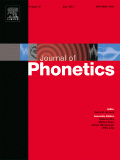This study analyzes an episode of a televised political talk show for evidence that speakers hyperarticulate concepts about which they express stances, a use of hyperarticulation that interacts with the discourse function of signaling new information. Using content analysis, utterances were coded on two dimensions: Evaluation (presence or absence of stance-expression) and Novelty (new or given information). To compare the resulting groups, four measures indicating hyperarticulation were used: speech rate of phrases, and the duration, pitch, and vowel space expansion (first and second formant values) of stressed vowels in the phrases. Group results showed significant effects for both Evaluation and Novelty, and an interaction between them. Stance-expressing items were hyperarticulated compared to a control group of neutral phrases, and within each group, new information was hyperarticulated compared to given information. Speech rate showed these effects most reliably, with vowel duration showing effects for Evaluation. Vowel space expansion showed the same patterns without statistical significance; pitch was not a reliable indicator. These findings provide acoustic correlates to stance-expression, which have not been extensively investigated previously and which can be applied in future work on the identification of specific types of stance.
